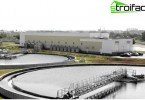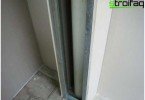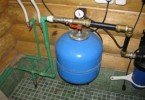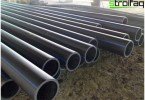Septic tanks for a country house
In the good old days, country houses most often represented small huts located on six hundredths of fertile (and sometimes not so much) land allocated to everyone who wanted for a summer cottage. The toilet was usually located in one of the farthest corners and usually looked as follows: a wooden floor with a hole was placed above the pit in the ground, and this structure was hidden from prying eyes by wooden walls. Naturally, few people thought about building such devices as septic tanks for a country house, since very little time was spent in the country.
A modern country house is a full-fledged housing, equipped with all amenities. Each owner tries to equip his cottage and facilitate living by building communal facilities. Almost every private house is equipped with a bathtub, toilet, a washing machine and a dishwasher are installed in it, water is supplied, and a bathhouse or cottage is built a little less often. As a result, there is a need for a sewer system, since the discharge of wastewater and household waste directly into nearby bodies of water or into the ground is not only ethically unacceptable, but is also considered a criminal offense.
Content
- Types of sewer facilities
- What is a septic tank
- The principle of operation of storage septic tanks
- Common types of treatment facilities
- Reinforced concrete septic tanks – the most popular scheme
- Plastic cleaning devices
- Septic tanks stainless steel
Types of sewer facilities
If you equip an ordinary cesspool, then even very frequent pumping of waste with the help of specialized equipment will not save the situation, since in this case the pathogenic microbes will still remain in the recess and may fall into the drinking water sources through underground water. In order to avoid this, it is necessary first of all to organize local sewage.
The main types of sewage:
- septic tanks;
- storage tanks;
- biological treatment plants equipped with aeration (forced enrichment with oxygen using a compressor);
- mixed structures (septic tanks with a biofilter).
In this article, we will consider in detail one type of sewer device – septic tanks installed in suburban areas.
Interesting: a septic tank could be called a full sewer, if not for one “but”: waste is not processed in the septic tank, they are only stored until pumped out in special compartments, and the water passing through the filter is discharged into the ground.
What is a septic tank
Septic – a system designed to collect and treat domestic wastewater for cottages and country houses.
The principle of operation of this device is gravity filtration (sedimentation of denser substances) and post-treatment using bioenzymes.
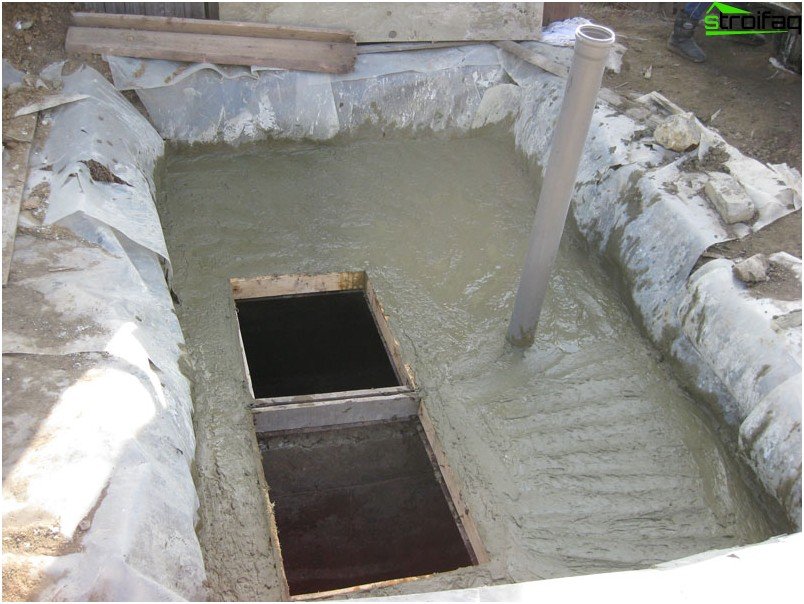
Installation of a septic tank
Advantages of installing a septic tank in suburban areas:
- Closed system ensures no unpleasant odors in the house.
- Environmental cleanliness of the system.
- Long life.
- Sufficiently high degree of wastewater treatment.
- No noise during system operation.
- Easy installation and ease of use.
The principle of operation of storage septic tanks
As you know, the proportion of pollutants in wastewater rarely exceeds 0.5% of the total. That is, the septic tank faces the task of isolating these substances, and drain the remaining clean water into the ground.
Let us consider in more detail how this happens..
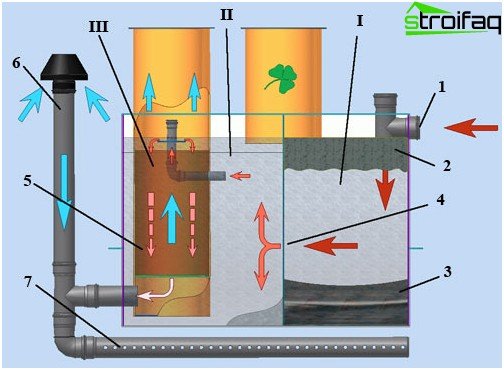
The device of septic tanks for a country house
Initially, the waste enters chamber I through the inlet pipe 1. Here, the waste is settled and divided into three parts:
– substances with the lowest specific gravity (2) form the upper one;
– in the middle is settled water;
– substances with a specific gravity greater than the weight of water fall to the bottom of the vessel (3).
The liquid is poured into the next chamber II at a third of the height of the device (4), therefore, the content of pollutants in the second tank will be much lower. Here the process is repeated, with the only difference being that there are no pop-up substances and the main emphasis is on those particles that were accidentally pulled into the second chamber during the process of falling to the bottom.
In the first two tanks, oxygen-free (anaerobic) fermentation also occurs, followed by the release of methane, as a result of which the bacteria found in all products of human activity eat them, turning these products into a biologically safe mass. A water shutter covering both chambers prevents unpleasant odors from leaking out.
The third chamber III is a reservoir filled with a special substance (5), for example, expanded clay. There is no water and air is constantly circulating. Aerobic bacteria eat the sediment formed by filtering the liquid from the second reservoir on the surface of the aggregate, converting it into vinegar and carbon dioxide. At the exit from the chamber, pure water is obtained that does not cause any harm to the environment. This compartment is not required to be cleaned, as it is considered self-cleaning, but to achieve a better result, it is worth changing the placeholder to a new one every few years.
But where do all the remaining substances go? All surfaced particles decompose over time and settle to the bottom, so the process of cleaning the septic tank is reduced to removing sludge at the bottom of the chambers. For this, the settled layer should be periodically pumped out using special equipment..
Tip: do not forget to provide a septic tank with ventilation to discharge the resulting gas.
More modern treatment systems are filtration septic tanks. They can be divided into two types:
- septic tanks with soil filtration, which are most common. This type of structure carries out filtration using bacteria existing in the soil;
- septic tanks with factory built-in biological filters, characterized by the introduction of specially created microorganisms.
All filtration septic tanks must be insulated in the cold season and in no case should they be cooled so that bacteria and anaerobic microorganisms that filter are not killed.
Advice: in order to prevent death bacteria in the septic tank at least a fifth of the sediment must be left at the bottom.
Common types of treatment facilities
There are several types of septic tanks, characterized by the material from which they are made:
- reinforced concrete;
- plastic;
- stainless steel.
Reinforced concrete septic tanks – the most popular scheme
Reinforced concrete septic tanks for a country house consumer reviews confidently bring to a leading position. Although the appearance of such devices is not distinguished by grace and beauty, but it is such a septic tank that is most suitable for the climate of our country. Of course, the installation of a reinforced concrete structure is somewhat more complicated than the other types, but its advantages compensate for all the inconvenience of installation. So, what is so good reinforced concrete septic tank?
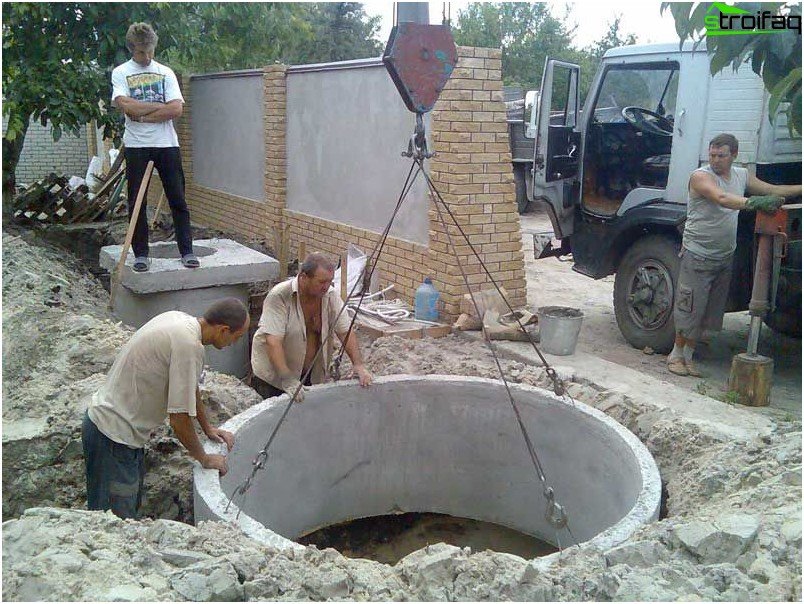
The volume of reinforced concrete septic tank is regulated by the diameter and the number of installed rings
- Such a design will never emerge, and the required volume can be achieved by adjusting the number of rings and containers assembled from them.
- Hygroscopicity of concrete can be improved by introducing various additives into it..
- Long service life (up to 30 years).
All containers are buried in the ground, and only one hatch remains on the surface, designed to add special bacteria and pump out sediment from the bottom.
Tip: the closer the concrete ring is to the surface, the more damage it undergoes, so it is better to use cement grade B-15 and higher for the upper part.
Plastic cleaning devices
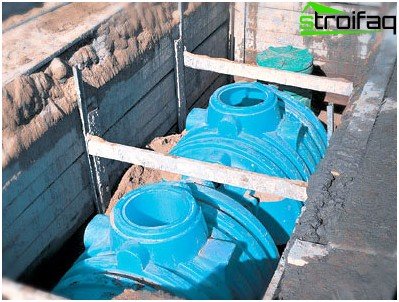
Plastic septic tanks are lightweight
Plastic septic tanks have one property, which is both a great advantage and no less significant drawback. Such designs are very light..
On the one hand, this is very good, since they can be transported over very large distances without much difficulty, and on the other hand, the ease of construction leads to its rapid rise to the surface, especially when installed in areas with loose soil and a large amount of surface water.
Tip: in order to prevent “ascent”, when installing plastic septic tanks, it is recommended to attach special cables or anchors to a reinforced concrete base. And to protect against damage by stones moving in the soil, they need to be reinforced with fiberglass.
It is worth noting that plastic structures have a long service life (up to 50 years) and ease of installation.
Septic tanks stainless steel
These septic tanks were not widely used. These structures are very heavy; a crane is required to install them. In addition, stainless steel is highly susceptible to corrosion, so even if the septic tank is treated with special substances, it is unlikely that it will be possible to maintain the tightness of the containers for a long time.
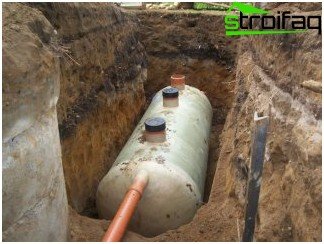
The metal septic tank is very heavy and requires the use of special equipment during installation
On the modern market, septic tanks from both domestic and foreign manufacturers are represented. All of them have their advantages, for example, Alta Bio polymer structures are highly reliable due to the presence of thickened walls (up to 10 mm). Septic tanks of the French brand Sotralentz offers septic tanks with a built-in primary sump that improves the quality of cleaning. The models of this company are completely non-volatile.
Making the final choice is only after a careful analysis of the requirements for the system and weighing all the positive and negative sides.


